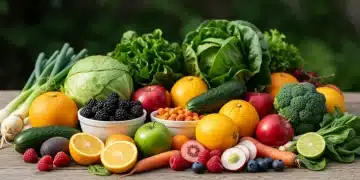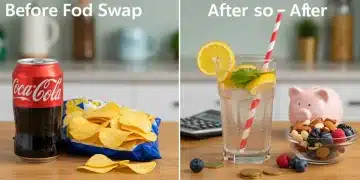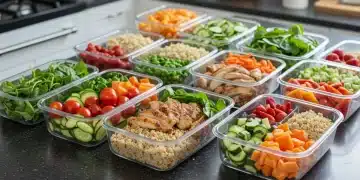Reusable vs. Compostable: Best Plastic-Free Coffee Habit 2025
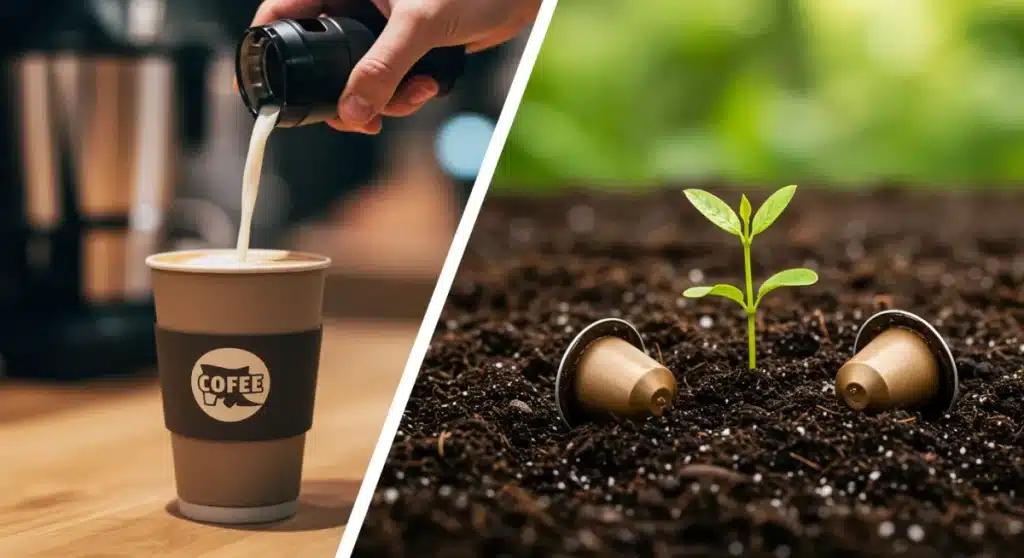
As of early 2025, the critical choice between reusable and compostable solutions for a plastic-free coffee habit hinges on balancing environmental impact, daily convenience, and evolving infrastructure.
The push for a plastic-free lifestyle is intensifying, and for many, the daily coffee ritual presents a significant challenge. As of early 2025, the crucial decision between reusable compostable coffee options has become more complex than ever, with new innovations and shifting consumer priorities impacting which choice reigns supreme. This in-depth analysis breaks down the latest developments to help you decide the best sustainable path for your coffee habit.
The Resurgence of Reusables: A 2025 Update
Reusable coffee cups and containers have long been championed as a primary solution for reducing single-use waste. In 2025, their appeal has only grown, bolstered by technological advancements and widespread adoption. New materials and designs are making reusable options more durable, portable, and aesthetically pleasing, addressing past consumer hesitations.
The infrastructure supporting reusables has also seen significant expansion. Coffee shops globally are increasingly offering incentives for bringing your own cup, and some urban centers are piloting ‘cup-sharing’ programs, further simplifying their use. This shift reflects a broader societal commitment to circular economy principles.
Advancements in Reusable Technologies
Material science is playing a crucial role in the evolution of reusable coffee containers. Innovations are focusing on enhanced insulation, lighter weights, and improved hygiene features, making them more practical for daily use.
- Smart Materials: Some new reusables feature integrated chips for loyalty programs or touchless payment, streamlining the coffee-buying process.
- Enhanced Durability: Manufacturers are using advanced ceramics, tempered glass, and high-grade stainless steel to create products that withstand years of use.
- Improved Portability: Collapsible designs and ultra-light materials are making it easier for consumers to carry reusable cups without added bulk.
Compostable Innovations: A Deep Dive into 2025 Options
Compostable coffee products, particularly pods and disposable cups, have emerged as a strong contender in the plastic-free debate. These options offer the convenience of single-use items without the lasting environmental impact of traditional plastics, provided they are disposed of correctly. The market for compostable solutions has diversified significantly in 2025, driven by consumer demand and stricter regulations on plastic waste.
Recent developments focus on creating materials that truly break down in various composting environments, from industrial facilities to home compost piles. This addresses past criticisms regarding the efficacy of ‘biodegradable’ claims and ensures a genuine end-of-life solution for these products.
Understanding Compostable Certifications
Navigating the compostable landscape requires understanding current certification standards. As of 2025, certifications like BPI (Biodegradable Products Institute) and TÜV Austria’s ‘OK Compost HOME’ are crucial indicators of a product’s true compostability.
- Industrial Composting: Many compostable items require specific conditions found in industrial composting facilities, including high temperatures and microbial activity, to break down effectively.
- Home Composting: A smaller subset of products are certified for home composting, designed to decompose in typical backyard compost bins under less controlled conditions.
- Regulatory Scrutiny: Governments are increasing oversight on ‘green’ claims, pushing manufacturers for clear labeling and verifiable certifications to combat greenwashing.
Environmental Footprint: Reusable vs. Compostable Efficacy
Assessing the true environmental impact of reusable versus compostable coffee solutions involves a lifecycle analysis, considering everything from raw material extraction to end-of-life disposal. This complex evaluation goes beyond immediate waste reduction to encompass energy consumption, water usage, and carbon emissions throughout a product’s existence. In 2025, new data and methodologies offer clearer insights into these impacts.
It’s no longer a simple case of ‘reusable is always better.’ The environmental performance of reusable items heavily depends on how many times they are used, the energy required for washing, and the materials they are made from. Similarly, compostable products’ benefits are contingent on access to proper composting infrastructure, which remains a challenge in many regions.
Key Environmental Metrics for Comparison
Recent studies highlight several critical factors determining the ecological advantage of each option. The manufacturing process for both types of products carries its own environmental burden.
- Carbon Emissions: Production of reusable items, especially those made from stainless steel or glass, can initially have a higher carbon footprint. This is offset only after a significant number of uses.
- Water Consumption: Washing reusable cups contributes to water usage, which must be factored into their overall environmental cost.
- Resource Depletion: Compostable products, while designed to return to the earth, still require resources for their production, often from renewable sources like corn starch or sugarcane.
Convenience and Lifestyle Integration in 2025
For many consumers, the practicality and ease of integrating a sustainable coffee routine into their daily lives are paramount. As of 2025, both reusable and compostable options have made strides in convenience, but each presents unique considerations that align with different lifestyles and priorities.
Reusable cups require a commitment to carrying, washing, and remembering them, which can be a barrier for some. However, the growing availability of cup-share programs and on-the-go cleaning solutions is mitigating these challenges. Compostable options, conversely, offer the ‘grab-and-go’ convenience of single-use, but their environmental benefit is entirely dependent on accessible and effective composting facilities, which are not universally available.
Adapting to Different Daily Routines
The optimal choice often depends on an individual’s specific habits and access to resources. A commuter with a consistent routine might find reusables more straightforward, while someone with unpredictable travel might lean towards compostables.
- Reusable User Profile: Individuals who frequent the same coffee shops, have access to dishwashers, and are disciplined about carrying their cup will find reusables highly convenient.
- Compostable User Profile: Those who prioritize speed, variety in coffee choices (e.g., different pod flavors), and have easy access to industrial composting or a home compost system will benefit most from compostables.
- Public Infrastructure: The presence of public composting bins and dishwashing stations in workplaces or public spaces significantly impacts the practicality of both options.
Cost Analysis: Investing in Sustainable Coffee
The financial implications of choosing between reusable and compostable coffee solutions are a significant factor for consumers in 2025. While the upfront cost of a reusable cup might seem higher, its long-term savings can be substantial. Conversely, compostable options often carry a premium compared to their plastic counterparts, reflecting the innovation and specialized materials involved.
Many coffee shops now offer discounts for customers bringing their own reusable cups, creating an immediate financial incentive. For compostable pods, the price per serving can be higher, but the convenience of brewing at home and avoiding daily café prices might still represent savings for some. Analyzing the total cost of ownership over time is essential for an informed decision.
Long-Term Savings and Initial Investments
The initial outlay for a high-quality reusable cup can range from $15 to $40, but this is a one-time expense that, with proper care, can last for years. This contrasts with the continuous purchase of compostable products.
- Reusable Cup ROI: With an average coffee shop discount of $0.25-$0.50 per drink, a reusable cup can pay for itself within a few months, leading to significant savings over its lifespan.
- Compostable Pod Premium: Compostable coffee pods typically cost 10-20% more than conventional plastic pods due to specialized materials and manufacturing processes.
- Bulk Purchases: Buying compostable products in bulk or subscribing to services can sometimes reduce the per-unit cost, making them more competitive.
Future Outlook: Evolving Standards and Consumer Trends
The landscape for plastic-free coffee solutions is continuously evolving, driven by technological innovations, shifting consumer preferences, and increasingly stringent environmental regulations. As of 2025, several key trends are shaping the future of both reusable and compostable options, suggesting a more integrated and sophisticated approach to sustainability.
Expect to see further advancements in material science, making both reusables more efficient and compostables more widely applicable. The focus will likely shift towards greater transparency in supply chains and clearer communication about product lifecycles, empowering consumers to make truly informed choices. Collaboration between industry, government, and consumers will be crucial in building robust infrastructure for both systems.
Emerging Technologies and Policy Changes
Upcoming developments promise to refine our sustainable coffee choices further. Governments are exploring policies that could standardize composting facilities and incentivize reusable systems.
- Advanced Bioplastics: Research into next-generation bioplastics capable of faster decomposition in diverse environments is ongoing, promising more versatile compostable solutions.
- Circular Economy Models: More businesses are adopting closed-loop systems for reusables, where cups are returned, professionally cleaned, and redistributed, minimizing individual responsibility.
- Digital Tracking: Blockchain and other digital tools are being explored to track the lifecycle of products, providing consumers with verifiable data on environmental impact.
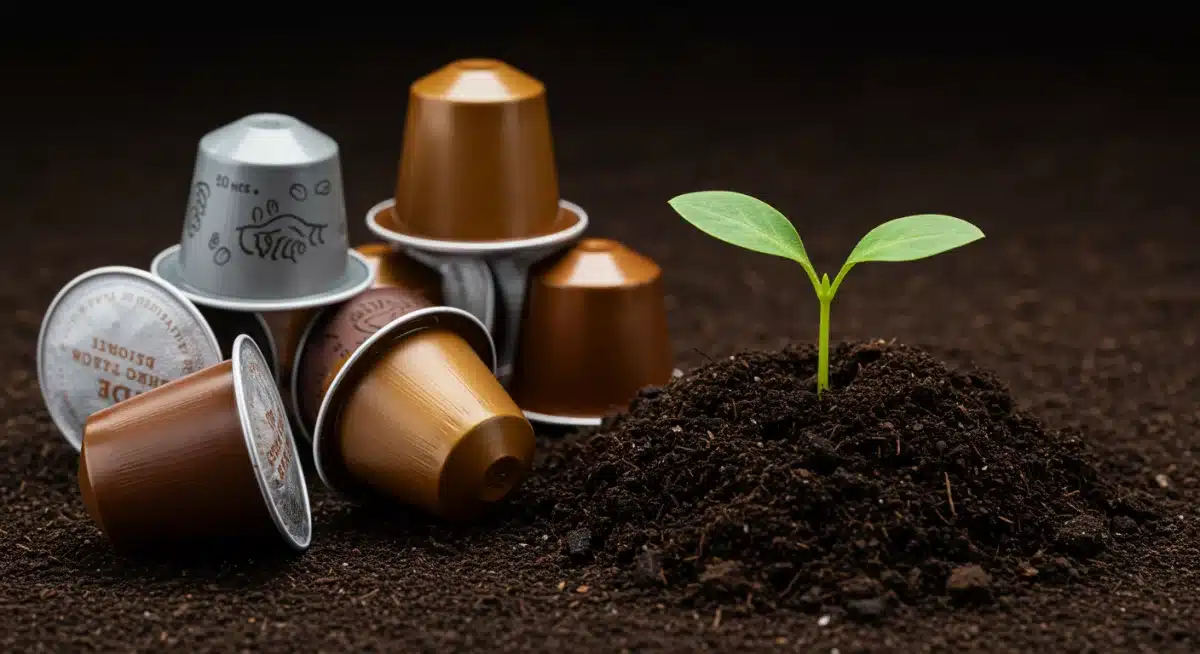
| Key Aspect | Brief Description |
|---|---|
| Environmental Impact | Reusable cups reduce waste with multiple uses; compostables minimize landfill burden if properly processed. |
| Convenience | Reusables demand carrying and washing; compostables offer single-use ease but require composting access. |
| Cost | Reusables have higher upfront cost, long-term savings; compostables often have a higher per-unit price. |
| Infrastructure Needs | Reusables need cleaning facilities/cup-share programs; compostables require effective industrial/home composting. |
Frequently Asked Questions About Plastic-Free Coffee in 2025
▼
Not always. Reusable cups generally have a lower environmental impact over their lifespan, but only if used many times. Their initial production footprint is higher, and washing uses water and energy. Compostable options are better if reusables aren’t consistently reused or if composting infrastructure is robust.
▼
The primary challenge for compostable coffee pods in 2025 remains the lack of widespread industrial composting facilities. Many ‘compostable’ products won’t break down in landfills or home composts, leading to confusion and improper disposal. Consumer education and infrastructure development are crucial.
▼
Studies suggest a reusable cup needs to be used between 20 to over 100 times, depending on its material and production, to offset its initial environmental footprint compared to a single-use cup. Stainless steel and ceramic cups require more uses than lighter plastic reusables.
▼
Yes, as of 2025, several regions are implementing stricter regulations on single-use plastics, including coffee cups. This includes bans on certain plastic items, mandates for compostable alternatives where feasible, and incentives for reusable systems, pushing both consumers and businesses toward more sustainable practices.
▼
No, not all ‘compostable’ coffee products are suitable for home composting. Many require the higher temperatures and specific microbial conditions found in industrial composting facilities. Always check for explicit ‘OK Compost HOME’ certification or similar labeling to ensure a product can be effectively home composted.
What Happens Next
As 2025 progresses, the discourse surrounding plastic-free coffee solutions will continue to evolve, driven by ongoing innovation and a heightened global awareness of environmental impacts. Expect to see intensified efforts in standardizing composting facilities and expanding reusable cup-sharing programs. Policymakers are likely to introduce more comprehensive regulations aimed at curbing single-use waste, potentially favoring harmonized approaches that integrate both reusable and truly compostable solutions. Consumers will increasingly demand transparency and verifiable sustainability claims, pushing manufacturers towards more eco-conscious design and robust end-of-life strategies. The goal remains a significant reduction in waste, requiring a collective and adaptive approach from all stakeholders.
